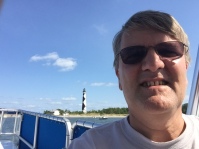You can collect stamps in a passport book for lighthouses as well as National Parks. As we traveled to historic forts and National Seashores, we were passing by lighthouses as well, so we included visits and collected 12 stamps.
Some lighthouses are part of a National Seashore, or adjacent to a National Historic Site. The location for lighthouses and the location for forts are both tied to the patterns of sea transportation. Often, when we were visiting a fort, a lighthouse was in view.
It started with Hatteras Light, which was our main destination for Cape Hatteras National Seashore (79). This lighthouse gets plenty of visitors because it is located in a vacation area. In 1999, International Chimney Corp., moved the Hatteras Light to protect it from the encroaching ocean, as the sand shifted through a natural process as storms wash over the island and carry sand from the ocean side to the bay side.
Its position along the coast provides interesting views of the coast and wetland habitats. The many water pools pictured are the result of Hurricane Matthew, which passed through North Carolina just days before our trip.
 Before we left the Outer Banks, we also visited the Bodie Island Light.
Before we left the Outer Banks, we also visited the Bodie Island Light.
We revised our travel plans to swing back to the coast for a visit to Cape Lookout National Seashore (81). This became one of my favorite National Parks. The lighthouse is on the barrier isla nd, similar to Cape Hatteras. But the only way to get there is by passenger ferry. The Ferry Captain arranged for us to use a beach wheel chair while on the island. That was a great help. The seashore also includes an island with feral horses, similar to Assateague
nd, similar to Cape Hatteras. But the only way to get there is by passenger ferry. The Ferry Captain arranged for us to use a beach wheel chair while on the island. That was a great help. The seashore also includes an island with feral horses, similar to Assateague  NS in Maryland. The ferry makes stops at several remote islands to let passengers off for day or overnight visits. This park has the beauty and beach recreation opportunities of Cape Hatteras without the crowds. I took the opportunity to get my feet in the Atlantic Ocean.
NS in Maryland. The ferry makes stops at several remote islands to let passengers off for day or overnight visits. This park has the beauty and beach recreation opportunities of Cape Hatteras without the crowds. I took the opportunity to get my feet in the Atlantic Ocean.
Many lighthouses are maintained by community groups to preserve their landmark. Some have elaborate museums and preserve the collection of buildings that served the lighthouse station.
As we traveled along the coast, the inlets and river deltas provide barriers to travel. That’s why there are lighthouses here. Sometimes, we traveled by ferry or over fancy new bridges (sorry, I am an engineer). This ferry carried us to Timucuan Ecological and Historic Preserve (87).
Near Castillo de San Marcos (89), we visited two lighthouses – St Augustine Light and Ponce de Leon Light. Sometimes the lighthouse is such a landmark that it inspires imitation.
We finished the Southern Tour with a visit to Canaveral National Seashore (90). This quiet seashore preserves some important wildlife habitat. But sometimes the neighbors are a bit noisy.
We took an overnight ride on Amtrak’s Autotrain from Sanford FL to Lorton VA. On the drive back to Pennsylvania, we detoured to one more fort and lighthouse at the mouth of the Potomac River. Fort Washington (91) protected the bay during the war of 1812 and the Civil War, and the lighthouse still serves as a channel marker for the approach to Washington, DC.
Here is your quiz question: What other famous landmark was moved by the International Chimney Corp.? Thanks to Carol for accompanying me on the South Tour to visit 18 National Parks and 12 Lighthouses.













The King of Prussia Inn
LikeLike
Right. What year?
LikeLike